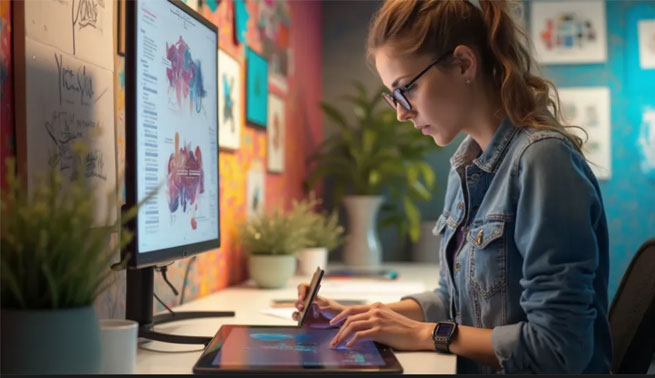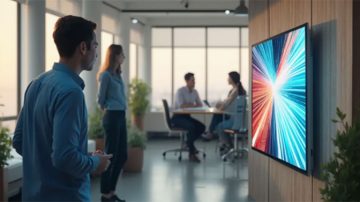The article outlines ten distinct types of graphic design, each serving unique functions and audiences, essential for effective visual communication in various industries. This classification is supported by examples and case studies demonstrating how these design types, such as visual identity, UI design, and motion graphics, contribute to branding, user experience, and marketing strategies, thereby enhancing overall market engagement and consumer connection.
Introduction
The realm of graphic design is vast and multifaceted, serving as a crucial component in the branding and marketing strategies of businesses across the globe. As the industry is projected to reach a staggering market size of $43.4 billion by 2025, understanding the core types of graphic design becomes essential for organizations aiming to enhance their visual identity and engage effectively with their audiences.
From visual identity and marketing design to user interface and motion graphics, each type serves a specific purpose that contributes to a brand’s overall success. This article delves into the various categories of graphic design, their real-world applications, and the pivotal role they play in shaping brand perception and user experience.
By exploring these elements, businesses can harness the power of graphic design to drive growth and foster deeper connections with their customers.
Exploring the Core Types of Graphic Design
The field of graphic creation includes different types of graphic designs, each serving specific purposes and audiences within the industry, which is projected to reach a market size of $43.4 billion by 2025. At RNO1, we are deeply committed to design-driven solutions that maximize marketability through our Return On Design & Digital (RODD) strategies. The core types of graphic design include:
Visual Identity Design: Essential for establishing different types of graphic designs, including logos, color schemes, and typography, which create a recognizable and cohesive identity. This aligns with the focus on creating strong visual branding that resonates with target audiences.
Marketing and Advertising Design: Focused on producing different types of graphic designs for promotional materials such as brochures, posters, and digital advertisements, this design type aims to attract and engage potential customers effectively, directly supporting the organization’s goal of enhancing brand visibility.
User Interface (UI) Design: Focuses on developing intuitive interfaces for software and machinery, ensuring they are user-friendly and visually attractive, which involves different types of graphic designs to improve user experience, essential for the organization’s digital growth strategies.
Publication Design: Involves the layout and design of printed materials like books, magazines, and newspapers, which are considered different types of graphic designs that prioritize readability and aesthetic quality to convey information effectively, thereby enhancing the content marketing efforts.
Different types of graphic designs, particularly packaging design, play a crucial role in creating product exteriors, including packaging and labels, significantly influencing consumer purchasing decisions by enhancing shelf appeal, which aligns with the company’s focus on product branding.
Motion Graphics: Involves the creation of animated graphics, which represent one of the different types of graphic designs often used in video content and online media, enhancing storytelling through dynamic visual movement, a key component in their digital marketing strategies.
Environmental Design: Concentrates on creating physical spaces, incorporating different types of graphic designs, including signage and wayfinding systems, to enhance the overall user experience in both public and private settings, reflecting the organization’s commitment to user-centered methodology.
Web Design: Encompasses different types of graphic designs, concentrating on layout, user experience, and visual aesthetics to effectively engage visitors and promote interaction, which is essential for the organization’s online presence.
Infographic design is one of the different types of graphic designs focused on creating visual representations of data and information, simplifying intricate ideas for audiences, which supports educational initiatives.
Illustration: Involves the creation of different types of graphic designs that serve as custom artwork utilized across various media, from books to advertisements, adding a unique and personal touch to visual communication, further enhancing RNO1’s branding efforts.
According to Maitrayee Dey, ‘Graphic creation plays a pivotal role in bridging technology and creativity, making complex topics easy to understand for diverse audiences.’ The hiring of visual artists in the computer systems development sector is anticipated to rise by 20% from 2016 to 2026, indicating the increasing need for these specialized abilities. Moreover, the gender ratio in visual arts is nearly balanced, with 50.2% female and 49.8% male creators contributing to a diverse workforce.
The majority of designers in the US are over 30, with 39% over 40 years old, indicating an experienced workforce that could be beneficial for tech startup founders considering hiring designers.
Real-World Applications of Graphic Design Types
Comprehending the applications of different types of graphic designs is crucial for leveraging their potential in real-world situations and promoting transformative growth.
Visual Identity Design: Major companies like Apple and Nike exemplify the power of different types of graphic designs, which foster loyalty and enhance recognition. Statistics show that it takes only 50 milliseconds to create a good first impression, highlighting the significance of effective visual identity in recognition. Campaigns from Coca-Cola illustrate how different types of graphic designs can create compelling visual communication that resonates with consumers, driving sales and boosting brand awareness. These strategies demonstrate the significance of innovative marketing in enhancing e-commerce engagement.
User Interface (UI) Creation: Applications such as Airbnb and Spotify demonstrate how well-crafted UI creation, which includes different types of graphic designs, improves user experiences and facilitates engagement. A seamless interface is critical for user retention and satisfaction, reflecting the transformative potential of UI in digital branding.
Publication Layout: Renowned publications like National Geographic depend on different types of graphic designs for expert publication layout to create visually captivating content that effectively conveys complex narratives, enhancing reader engagement.
Packaging Design: The elegant packaging of names like Tiffany & Co. showcases different types of graphic designs that elevate product perception and value, directly influencing consumer purchasing decisions. Thoughtful packaging creation enhances the overall brand experience and customer anticipation. Dropbox effectively employs different types of graphic designs, such as motion graphics, in its explainer videos, simplifying intricate concepts and engaging viewers. This style conveys information quickly and dynamically, which is crucial in modern digital marketing.
Environmental Planning: Airports and museums implement different types of graphic designs in their environmental planning to enhance navigation and overall visitor experience, contributing significantly to the functionality of public spaces.
Web Development: E-commerce giants like Amazon utilize effective web development and different types of graphic designs to enhance user experience and maximize conversion rates. An intuitive and visually appealing website can profoundly impact customer behavior. Media organizations such as The New York Times utilize different types of graphic designs, like infographic design, to present data engagingly and understandably, enhancing information retention and audience engagement. Brands like MailChimp utilize different types of graphic designs, including custom illustrations, to infuse personality into their marketing materials, fostering deeper connections with their audiences. Illustrations can make complex ideas more relatable and memorable.
Incorporating case studies into a portfolio can significantly enhance its impact, as noted by the firm Fi. For instance, our collaboration with Microsoft highlights how we elevated presentation components to new heights, fostering scalable brand growth. Furthermore, our partnership with RentMethod, which resulted in its purchase by Airbnb, illustrates the transformative potential of effective planning.
For further insights into innovative strategies, readers can explore weekly startup insights at the startup design system.com. View case study.
The Role of Branding in Graphic Design
Branding is essential in visual creation, as it encompasses different types of graphic designs that act as the visual representation of a company’s identity. At RNO1, we support the development of purpose-driven companies through a comprehensive approach that includes strategy activation, identity creation, and market adoption. Our services include Brand Strategy & Experience Guidelines, which help businesses articulate their values, mission, and personality to their audience.
Effective visual communication enables this articulation through key components:
Consistency: A uniform application of colors, fonts, and imagery across all platforms enhances recognition and reliability. Recent studies suggest that a consistent presence can greatly affect consumer trust, as 65% of shoppers recognize the effect of a company’s leadership on their buying choices.
Differentiation: Different types of graphic designs featuring unique visual elements can efficiently distinguish an entity from its rivals, forming a memorable identity that connects with consumers. This distinction is essential in a crowded market where initial perceptions are important, aligning with RNO1’s aim to enable companies through innovative creative strategies.
Emotional Connection: Different types of graphic designs, when thoughtfully created, can elicit particular feelings, nurturing a stronger bond between the company and its audience. As noted by Squarespace, more than 40% of people say blue is their favorite color, illustrating how color choices in branding can significantly influence consumer preferences. Such emotional involvement is essential for boosting customer loyalty, as consumers are more inclined to support companies that connect with them personally.
Trust and Credibility: Different types of graphic designs through high-quality visual creation convey professionalism and reliability, instilling trust in consumers. A well-crafted emblem and consistent identity indicate to consumers that a company is trustworthy and deserving of their patronage.
Storytelling: Different types of graphic designs serve as a powerful medium for conveying a company’s narrative, values, and mission, thereby engaging audiences on a profound level. As emphasized in the case study ‘Graphic Design Facts and Branding Stats,’ effective storytelling through design significantly impacts consumer behavior and perception. The data highlights that a professional logo, website, and consistent identity can significantly influence consumer behavior and perception. Additionally, 31.8% of marketers struggle with producing engaging visual content consistently, underscoring the challenges that brands face in maintaining effective branding strategies. RNO1’s dedication to careful selection of choices is crucial in establishing an emotional connection, ultimately driving purpose and profitability in the eCommerce landscape. Our featured case study demonstrates how we successfully connected the dots for a client, resulting in measurable growth and enhanced market presence.
User Interface Design: Enhancing Digital Experiences
User Interface (UI) creation is a crucial aspect of different types of graphic designs, emphasizing the layout and interactive features of digital interfaces. Its significance is affirmed by several key factors:
User Experience (UX): Effective UI arrangement significantly enhances the overall user experience, rendering digital products more intuitive and enjoyable to navigate. Research indicates that even a modest 5% improvement in UX can lead to a remarkable 25% increase in profitability. As we enter 2024, the significance of these enhancements cannot be exaggerated, particularly regarding transformative digital branding collaborations such as those enabled by RNO1, which involve partnerships with Microsoft and Spring Labs.
Accessibility: Considerate interface construction prioritizes accessibility, ensuring that all users, including those with disabilities, can effortlessly navigate and interact with digital content. This is a vital factor in the changing environment of user interface development, especially as the organization collaborates with clients to update their digital experiences.
Visual Hierarchy: UI creation utilizes visual hierarchy purposefully to guide users’ attention toward essential elements, thereby enhancing navigation and usability. The organization’s partnerships in diverse sectors exemplify this approach, enhancing user engagement across various platforms.
Feedback Mechanisms: A high-quality UI incorporates feedback mechanisms, such as hover effects and notifications, which inform users about their actions and bolster engagement. According to Annemarie Bufe, Content Manager,
It takes less than 500ms, or even just 50ms, to make a good first impression.
This emphasizes the necessity for prompt feedback, which is crucial in keeping user interest.
Consistency: Upholding uniformity in visual elements across different screens encourages familiarity and comfort for users, enhancing prolonged engagement and a stronger connection with the product. RNO1’s creative initiatives with platforms like Figure demonstrate the effectiveness of this approach, creating human-centric digital experiences.
AI Integration: As technology evolves, AI is not expected to replace UX creators but to enhance their capabilities in the creation process. This entity incorporates AI to deliver tailored user experiences, employing data-informed insights to guide creative choices.
A remarkable instance of effective UI development can be observed in its collaboration with Housing.com, which revamped its search capabilities to improve user experience. This initiative led to a 20% rise in feature adoption, showcasing the tangible advantages of effective UI. Moreover, the partnership of this entity with other firms, like Spring Labs and Microsoft, highlights their innovative approaches in developing user-centered solutions.
As advancements continue in the field, the emphasis on different types of graphic designs that prioritize accessibility and user-centered approaches will remain pivotal, particularly as RNO1 continues to innovate across client engagements.
Emerging Trends in Graphic Design
The scenery of visual communication is consistently reshaped by technological innovations and evolving consumer preferences. As we look toward 2024, several emerging trends are poised to make a significant impact:
Motion Graphics: These dynamic visuals are becoming increasingly integral to digital marketing strategies, as they effectively capture audience attention and elevate storytelling capabilities. The expansion of motion graphics in marketing is highlighted by the anticipated $1.5 billion input of virtual reality (VR) and augmented reality (AR) technologies to the visual arts sector by 2025.
Sustainable Creation: With increased awareness of environmental concerns, creators are prioritizing eco-friendly materials and practices. This shift not only meets consumer demand for sustainability but also aligns with broader societal goals, showcasing a commitment to responsible design.
Minimalism: A movement toward simplicity in design is gaining traction, as minimalist aesthetics facilitate clear communication. By reducing clutter, designers enhance focus and ensure that key messages resonate more effectively with audiences.
Augmented Reality (AR): The incorporation of AR technologies allows visual designers to create interactive experiences that deeply engage users. This innovative approach not only enhances user interaction but also opens new avenues for creative expression in design.
Bold Typography: Recent trends reveal a growing emphasis on bold and expressive typography. Designers are leveraging striking text elements as central features of their work, thereby increasing visibility and overall impact.
In addition to these trends, it’s important to note that the average hourly wage for visual designers is $26, with freelance designers earning between $20 to $150 per hour. This economic context underscores the professional opportunities available in this evolving field.
As noted by industry expert David Mercado,
Some studies have suggested that women may have an advantage in fields that require creativity, empathy, and emotional intelligence, which is why visual communication may be very appealing to most women.
This highlights the diverse talent pool that contributes to the evolution of graphic design, particularly in these emerging trends, as a variety of perspectives can enhance creativity and innovation in design solutions.
Conclusion
The exploration of graphic design reveals its critical role in shaping brand identity and driving business growth. Each type of graphic design, from visual identity and marketing to user interface and motion graphics, serves a distinct purpose that collectively enhances a brand’s engagement with its audience. The insights provided illustrate how effective design not only fosters brand recognition but also influences consumer behavior and loyalty.
Understanding the real-world applications of these design types underscores their importance in achieving tangible results. Major brands exemplify how strategic design choices can elevate market presence and consumer trust. Additionally, the emphasis on branding within graphic design highlights the need for consistency, differentiation, and emotional connection, all of which are essential for building a trustworthy and memorable brand.
As the industry evolves, staying abreast of emerging trends such as motion graphics, sustainable design, and augmented reality will be vital for businesses looking to remain competitive. The integration of these innovations promises to enhance user experiences and expand the creative possibilities within graphic design.
In summary, leveraging the various types of graphic design is crucial for any organization aiming to strengthen its market position and forge deeper connections with consumers. Embracing effective design strategies can lead to significant growth, making it an indispensable element of modern branding and marketing efforts.
About the author:
We’re west coast change-makers, in a complex world. The brands we support are positioned to be purposeful and powerful while also fluid and free-forming. We’re embracers of change. When we drive the change, a brand can connect with its audience, captivate the hearts and minds of customers, and convert cross-channel.





